0001 These comments are offered on my blog as a sample of the character of works that are available for sale at www.smashwords.com. They seem rather dry and technical. Nevertheless, they offer an innovative postmodern approach that should interest enterprising students and scholars. Here, the category-based nested form and the two-level interscope come into play.
These categorical structures are introduced in A Primer on the Category-Based Nested Form and A Primer on Sensible and Social Construction.
0002 J.B. Stump offers his views in the March issue of Perspectives on Science and Christian Faith (volume 72(1), pages 15-24). Perspectives is the flagship publication of the American Scientific Affiliation. Stump’s article may be available for download at their website. If not, please request.
Stump addresses the question, “Did God guide our evolution?”
He reviews several broad ways to answer, then discusses his favorite.
0003 So, does God guide our creation?
What about the scientific description of human evolution?
These questions point in different directions, C2 and C1.
The second direction (C2) is that God intentionally creates human beings in His image.
The first direction (C1) claims that evolution is the best scientific explanation for the origin of our species, Homo sapiens.
0004 These two claims can both be formulated as category-based nested forms (CBNF).
The CBNF contains four expressions. The fourth is paradigmatic. A normal context3 brings an actuality2 into relation with the possibility of ‘something’1. The subscripts refer to Peirce’s categories.
0005 Now, I associate features in each direction to the CBNF.
The normal context3 for C1 is science3. The normal context3 for C2 is the Genesis portrayal of God’s work3.
The actuality2 for C1 is human evolution2 and for C2 is the Genesis creation of humans2.
The potential1 for C1 is ‘natural selection and genetics’1. The potential1 for C2 is ‘the picture of humans as images of God’1.
0006 Here is how that looks in technical notation.
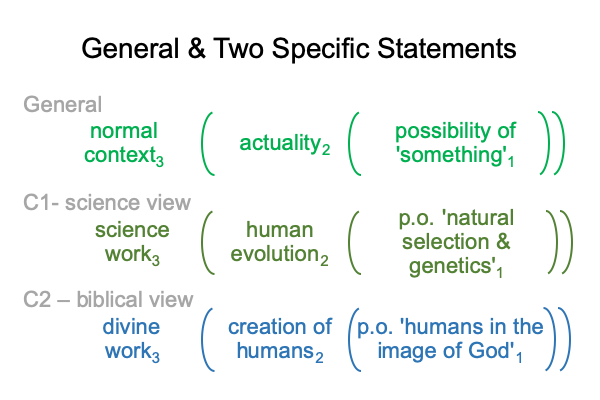
0007 So, did God guide our evolution?
According to Stump, the first strategy (A1) for answering the question relies on semantics.
I ask, “What problem does semantics solve?”
Well, I see two nested forms. How do they interact?
0008 Normal contexts follow the logic of exclusion, alignment and complement.
If they exhibit the logic of exclusion, the nested forms come into conflict. It’s God’s work3 or science work3. It is either one or the other.
If the logic is complement, then one could end up with Steven Gould’s idea of “non-overlapping magisteria”. This is not much of a complement. Perhaps, a truce is a better description.
If they exhibit the logic of alignment, then one nested form virtually emerges from (and situates) the other. This structural relation is called a “two-level interscope”. The two levels are contenta and situationb. Contenta goes with Peirce’s category of firstness (the realm of possibility). Situationb associates with Peirce’s category of secondness (the realm of actuality).
The two-level interscope has two flows.
In the upward flow, contenta underlies situationb.
In the downward flow, situationb orders contenta.
0009 So, I have two statements (C2 and C1) and two levels. Which goes with which?
Here is where semantics comes into play. Semantics is about language. When I talk about science, my words are usually content-oriented. When I think about God’s creation, I am contemplating my own (and everyone else’s) situation.
There is another, more technical semantic argument. The religious statement (C2) cannot be situated by the science statement (C1), because the Positivist’s judgment rules out metaphysics. The Positivist’s judgment is developed in Comments on Jacques Maritain’s Book (1935) Natural Philosophy. I cannot help but smile at this application. From a semantic point of view, how could science situate a nested form that it cannot consider?
Here is a picture of the semantic-ordered, two-level interscope.
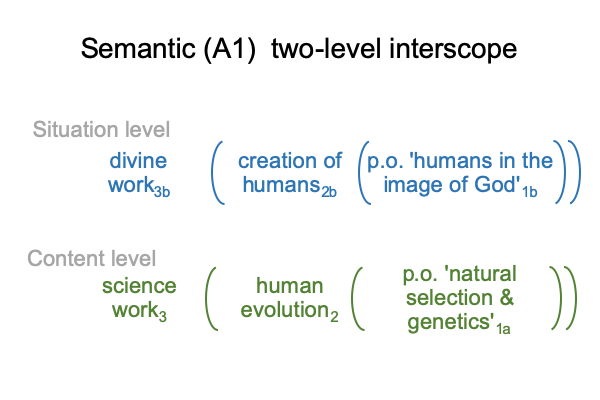
0010 Ironically, this model initiates questions that key into Stump’s second answer, the nomological strategy (A2). The nomological strategy suggests that the laws of human evolution are not well understood. The laws of evolution may be, but there is something wrong with their application to human evolution. Stumps reviews some critical arguments.
0011 The two-level interscope pictured above endorses the “yes, but” character of the nomological approach, addressing the question, “Did God guide human evolution?”
If science is so smart, then it should situate the religious nested form, rather than the other way around. The fact that the Positivist judgment excludes metaphysics indicates that science can understand human evolution only in terms of material and instrumental causalities. However, I personally situate the evolution of my species in terms of my religious sensibility, which involves immaterial causalities, such as final attributes and formal design.
What does this imply?
The ultimate human niche is not material.
Indeed, this is the central thesis of the masterwork, The Human Niche, available at www.smashwords.com.
0012 The semantic (A1) strategy may be adjusted by the nomological (A2), producing something like this.
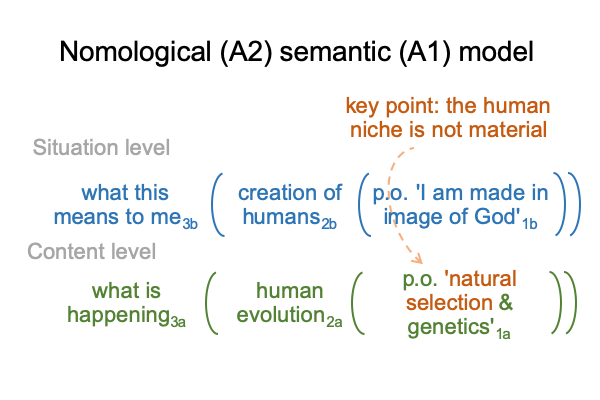
0013 Well, if our hominin ancestors adapted over millions of years into a niche that is not material, then the third answer, the causal joint strategy (A3), comes into play. The causal joint strategy suggests that God does not obviously intervene in human evolution, but God nevertheless creates. The question is, “How?” Stump considers several authors with very curious answers.
0014 These answers have something in common.
They exploit the dynamics of the two-level interscope.
The divine situationb guides the science contenta.
The scientific contenta underlies divine subtle interventionb.
“Subtle” means “below the threshold of detection”.
0015 How could this happen?
I only need to substitute God’s Will3b for the situation-level actuality3b and God’s Presence1b for the situation-level potential1b.
Here is how that looks.
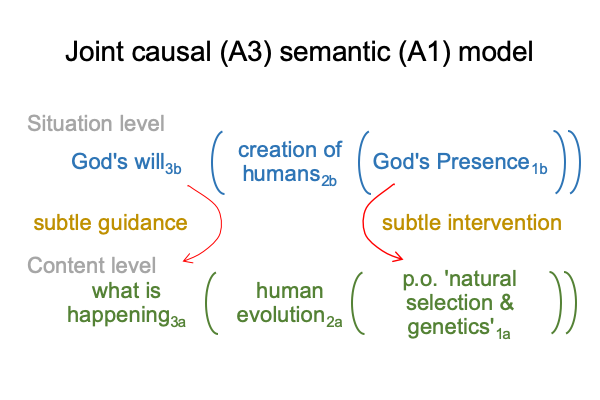
0016 God’s Will3b associates to God’s work3b and what this means to me3b.
God’s Will3b provides subtle guidance to science work3a and what is happening3a.
Subtle guidance underlies the Anthropic Principle.
God’s Presence1b associates to the potential of humans (including me) being created in the image of God1b.
0017 How does God’s Presence1b manifest?
God’s Presence1b is the potential underlying God’s will3b. Also, it1b stands in the slot 1b, which is the potential1b of situating the content level actuality2a. This associates God’s Presence1b with the potential of situating human evolution2a.
This potential to situate operates according to joint causes, in the realm of possibility1.
God’s Presence1b virtually situates (and is emergent to) the potential of ‘natural selection and genetics’1b. The word, “virtual”, means “in virtue” (rather than the modern use, “in simulation”). The term, “in virtue”, goes with final attributes and formal design.
So, while the stuff of Neodarwinism may be scientifically regarded according to material and instrumental causes, the virtue of God’s Presence1b cannot be fully ignored in either the adaptation1a or the phenotype1a. This is the central point of the joint causal (A3) answer. Biologists cannot avoid joint causality when they discuss adaptation or phenotype. Many modern biologists label God’s Presence1b, “chance1b” or “random1b”.
0018 In sum, divine subtle intervention operates in the realms of normal context3 and potential1, as pictured above. Neither of these can be scientifically observed or measured.
0019 The pertinence of the joint causal (A3) semantic (A1) approach does not stop there.
Adaptations1a and phenotypes1a are actualities that have the potential1a of underlying human evolution2a.
That means that adaptations2 and phenotypes2 are actualities with their own nested forms.
One can imagine that God directly intervenes in either nested form by manipulating its underlying potential. Such intervention avoids detection because the actualities, adaptation2 and phenotype2 refer to the same biological entity2. In other words, two actualities2 constitute a single entity2. Therefore, the two actualities2 are confounded.
0020 Let me develop this scenario in a little more detail.
Neodarwinism1a consists in two independent nested forms, as noted in Comments on Dennis Venema and Scot McKnight’s Book (2017) Adam and the Genome. These nested forms belong to the situation-level of a two-level interscope.
In one, natural selection3b brings adaptation2b into relation with a niche1b. The niche1b is the potential1b of situating an actuality independent of the adapting species2a.
In the other, body development3b brings phenotype2b into relation with genotype1b. The genotype1b is the potential1b of situating DNA2a.
In the joint causal answer, God could directly manipulate either an actuality independent of the adapting species2a, the foundation of the niche1b, or DNA2a, the foundation of the genotype1b, without detection. Why? A change in one can mask a change in the other. They are confounders.
0021 Here is a picture of these independent category-based nested forms.
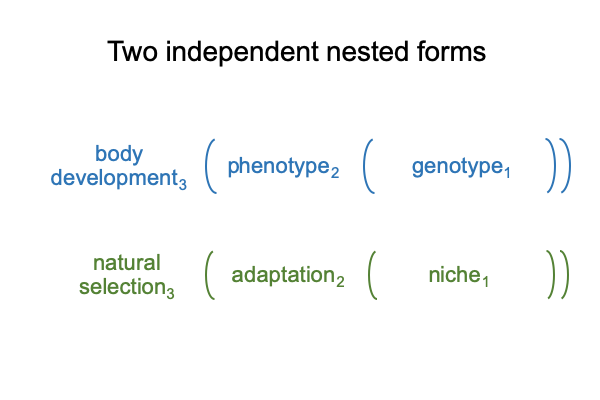
0022 The adaptation2 is not the same as the phenotype2. Each arises from a different potential1. Each requires its own normal context3. However, adaptation2 and phenotype2 pertain to a single actuality2, the biological entity, in this case, the human being2. The human being is the intersection of adaptation2 and phenotype2.
According to the chapter on presence in How to Define the Word “Religion”, intersections are mysterious. They contain contrasting features that cannot be resolved through the logic of noncontradiction. Biologists present distorted views when they claim that evolution consists in either natural selection or DNA-based body development. The intersection of these two nested forms codifies what biologists are really trying to say, but fail, because of preferences for either natural history or genetics.
0023 So, the joint causal answer suggests that, even if God directly manipulates the actualities underlying the niche1b or the genotype1b, scientists could never detect the intervention, because the evolved biological entity2 is an intersection, filled with contradictions.
Here is how that looks.
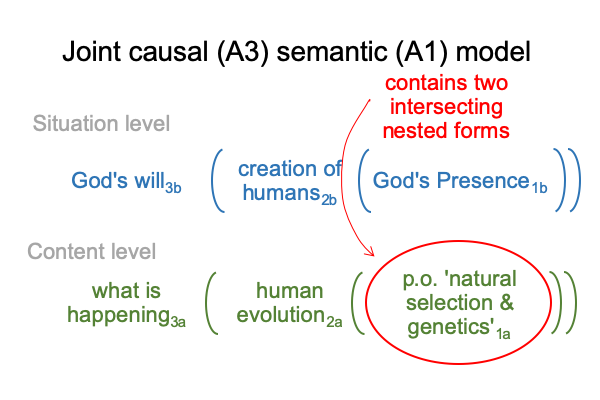
0024 This brings me to Stump’s favorite strategy (A4), the epistemological.
The epistemological strategy highlights the contrast between science work3a and God’s work3b, while simultaneously asserting that they cannot be divorced. I am a product of human evolution2a. I am created in the image of God2b. Science work3a is what is happening3a. God’s work3b is what this means to me3b.
Here is a picture of that strategy.
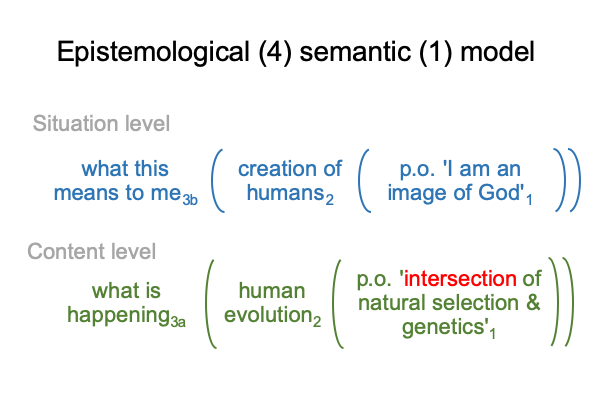
0025 Now, I address the elephant in Stump’s room.
I do so in a roundabout way.
I start with a question about the question.
0026 Does God guide human evolution?
What is the difference between this question and…
Did God guide human evolution?
0026 One strategy to answer this question is semantic (A1).
Human evolution is in our past. Are we no longer are evolving? It sure seems that we aren’t. In fact, who knows what we are doing?
0027 What does this imply?
The nomological strategy (A2) comes to bat.
Homo sapiens comes into existence, and lives for some time, in the Lebenswelt that we evolved in.
Currently, we are no longer in the Lebenswelt that we evolved in.
Therefore, our current Lebenswelt is not the Lebenswelt that we evolved in.
I conclude that a transition from one Lebenswelt to the other is missing in current accounts of human evolution.
This missing element is hypothesized in The First Singularity and Its Fairy Tale Trace and reflected upon in Comments on Original Sin and Original Death: Romans 5:12-19. This transition is dramatized in An Archaeology of the Fall, available on www.smashwords.com.
0028 With this said, the joint causal strategy (A3) cannot be ignored.
If (as proposed in The Human Niche), humans adapt into the niche of immaterial triadic relations (such as the category-based nested form), then God’s work3b virtually situates nature’s operations, as understood by science3a. In our evolution, the material world enters into an evolving awareness of immaterial triadic relations, without compromising its instrumental and material causalities.
0029 On top of that, the epistemological strategy (A4) says that God’s work3b and science work3a cannot be divorced, in the same way that what this means to me3b cannot be divorced from what is happening3a.
0030 So obviously, the elephant in the room is concordism.
Did God guide human evolution? How does God guide us today?
These questions aim to harmonize scientific formulations and Biblical revelation.
Stump is on target. Four different strategies apply. But, the target is so much larger than he realizes.
For example, Comments on Christy Hemphill’s Essay (2019) “All in a Week’s Work” introduces a harmony between cognitive psychology and metaphors within Genesis 1.
The concord between humans created in the image of God2b and human evolution2a will prove to be multi-faceted, addressing who we are2b as well as who we evolved to be2a.
0031 My thanks to J.B. Stump for publishing his evocative article.
****
Feel free to e-mail comments and corrections.
